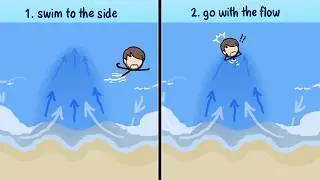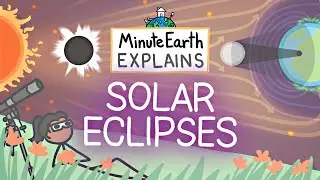The Deadliest Thing At The Beach
Our newsletter: https://news.minuteearth.com/subscribe
Earthling Pride Tee: https://store.dftba.com/collections/m...
You might think the most dangerous thing that can happen at a beach is a shark attack, or that the scariest thing might be a tsunami - but instead, rip currents kill more beachgoers than all other causes combined.
LEARN MORE
**************
To learn more about this topic, start your googling with these keywords:
Jetty: a breakwater constructed to protect or defend a harbor, stretch of coast, or riverbank.
Rip current: a relatively strong, narrow current flowing outward from the beach through the surf zone and presenting a hazard to swimmers.
Rip tide: a strong current caused by tidal flow in confined areas such as inlets and presenting a hazard to swimmers and boaters. A similar but distinct phenomenon often confused for a rip current.
Sandbar: a deposit of sand forming a shallow area in the sea or a river.
Surf zone: the area of the ocean where waves break near the shoreline.
Undertow: a current of water below the surface and moving in a different direction from any surface current. Also distinct from a rip current.
Wave Set Up: elevation of the mean water level at the shoreline due to wave breaking in the surf zone.
SUPPORT MINUTEEARTH
**************************
If you like what we do, you can help us!:
Become our patron: / minuteearth
Our merch: http://dftba.com/minuteearth
Our book: https://minuteearth.com/books
Share this video with your friends and family
Leave us a comment (we read them!)
CREDITS
*********
Cameron Duke | Script Writer, Narrator and Director
Lizah van der Aart | Storyboard Artist
Sarah Berman | Illustration, Video Editing and Animation
Nathaniel Schroeder | Music
MinuteEarth is produced by Neptune Studios LLC
https://neptunestudios.info
OUR STAFF
************
Lizah van der Aart • Sarah Berman • Cameron Duke
Arcadi Garcia i Rius • David Goldenberg • Melissa Hayes
Alex Reich • Henry Reich • Peter Reich
Ever Salazar • Leonardo Souza • Kate Yoshida
OUR LINKS
************
Youtube | / minuteearth
TikTok | / minuteearth
Twitter | / minuteearth
Instagram | / minute_earth
Facebook | / minuteearth
Website | https://minuteearth.com
Apple Podcasts| https://podcasts.apple.com/us/podcast...
REFERENCES
**************
Brander, Robert W. “Rip Currents.” Encyclopedia of Earth Sciences Series/Encyclopedia of Earth Sciences, 1 Jan. 2019, pp. 1442–1447, https://doi.org/10.1007/978-3-319-938...
Castelle, B., et al. “Rip Current Types, Circulation and Hazard.” Earth-Science Reviews, vol. 163, Dec. 2016, pp. 1–21, www.sciencedirect.com/science/article/pii/S0012825216303117, https://doi.org/10.1016/j.earscirev.2...
Leatherman, Stephen P. “Undertow, Rip Current, and Riptide.” Journal of Coastal Research, vol. 28, no. 4, 1 July 2012, https://doi.org/10.2112/jcoastres-d-1...
Masselink, Gerd, et al. Introduction to Coastal Processes and Geomorphology. Routledge, 4 Apr. 2014.
McCarroll, R. Jak, et al. “Evaluation of Swimmer-Based Rip Current Escape Strategies.” Natural Hazards, vol. 71, no. 3, 25 Dec. 2013, pp. 1821–1846, https://doi.org/10.1007/s11069-013-09...
US Department of Commerce, National Oceanic and Atmospheric Administration. “Rip Currents - Currents: NOAA’s National Ocean Service Education.” Noaa.gov, 2019, oceanservice.noaa.gov/education/tutorial_currents/03coastal3.html
Withers, Archie, and Sergio Maldonado. “On the Swimming Strategies to Escape a Rip Current: A Mathematical Approach.” Natural Hazards, vol. 108, no. 2, 22 Apr. 2021, pp. 1449–1467, https://doi.org/10.1007/s11069-021-04...































